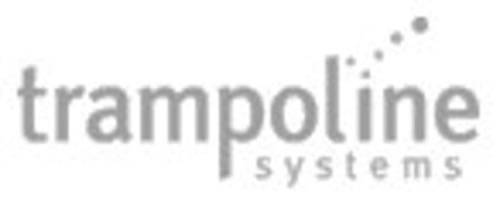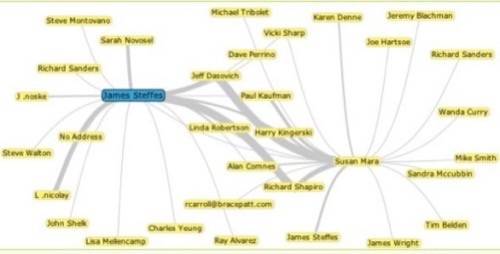I
wrote a piece back in January called IBMÄôs
Entry Into Social Networking, where I discussed the potential for applying
web 2.0 techniques in the enterprise. Subsequently, I have written extensively
about Enterprise 3.0 and the
Extended Enterprise trends. A company from England contacted me after
reading the IBM piece. This company, Trampoline
Systems, is the subject of our discussion today. Its tagline is
“Enterprise software that harnesses social behavior”. The value
proposition is Expertise Location within the enterprise, which
encompasses relationships in the Extended Enterprise. I find the product a great
combination of NLP (Natural language processing), Knowledge Management, and Web
2.0.

Editor’s Note: the rest of this post takes an in-depth look at
Trampoline’s features. Some of the information below is very technical,
particularly the terminology. But it’s a great introduction to the product, if
you are interested in Enterprise software that uses web 2.0 principles.
Incidentally, they are also
presenting at ETech today.
What is Trampoline SONAR
TrampolineÄôs SONAR platform brings a fresh approach to information
management, by harnessing the social behaviour that occurs within organizations.
SONAR plugs into the corporate network and connects to existing systems,
including email servers, contact databases and document stores. It analyses this
data to map social networks, information flows, expertise and individualsÄô
interests throughout the enterprise. Finally, a truly useful application for
social networking, or rather professional networking! Rather than the
LinkedIn-like approach, where users need to keep their profiles updated, SONAR
is an automatic knowledge mapping system.

SONAR allows an organization to leverage the embedded intelligence of the
whole community, as well as information stored electronically. Unlike
traditional knowledge management applications, SONAR takes account of the ÄòsoftÄô
or hidden knowledge assets contained within an organization Äì for example the
expertise employees pick up during their tenure at a company, but which is never
formally recorded. With SONAR, individuals get the information they need
instantly, unrecognized expertise becomes visible, the enterprise increases the
reuse and value of its knowledge assets, and the firm improves its agility and
competitiveness.
At the core of SONARÄôs technology is a combination of social network
analysis and natural language processing, which unites information contained in
multiple electronic forms and the social behaviour surrounding it.
SONAR works around two key concepts: Connections and Themes.
Connections are the people who users communicate with. They might be project
team mates, other employees or contacts in outside organizations. Themes are
topics of interest. They might be projects, deals or areas of expertise Äì
whatever people are communicating about.

About SONARÄôs Theme Extraction Technology
Theme Extraction is one of the main services provided by SONAR’s Intelligence
Core module. It automatically identifies the expertise and interests of
individuals and groups inside an enterprise, as well as external contacts in
communication with the enterprise.
SONARÄôs Theme Extraction method is designed to maximize the value of
results and efficiency of deployment in enterprise environments. SONAR Theme
Extraction functions without the need for lengthy consultancy to compile a
taxonomy at the deployment stage, so the system begins to give value as soon as
it is connected to an email server, instant messaging platform or document
repository.

Inside Theme Extraction
SONAR uses multiple language models to enable comparisons between the results
it extracts from text. Core measures focus on the pair of characteristics ÄòphrasenessÄô
and ÄòinformativenessÄô Äì i.e. whether a string of words is a meaningful
phrase rather than a chance juxtaposition, and whether a combination of words
has significance within its context. The combination of phraseness and
informativeness into a single score produces a measure of ÄòkeyphrasenessÄô,
the extent to which a phrase encapsulates a core idea of the text. SONAR scans
pairs and triplets of words in their context, ranks them by keyphraseness and
displays the top results to the user as themes.
Foreground and background content
The system is predicated on an understanding that the corpus in question is
composed of ÄòforegroundÄô and ÄòbackgroundÄô content. The foreground
content is the text in focus at a particular moment, and the background is the
wider group of data from which it is taken. For example, a single email can be
seen as foreground or focus information, with the background being the userÄôs
entire email archive; or the foreground could be the userÄôs entire email
corpus in comparison to the background of the whole enterpriseÄôs email
content. Additionally, to expedite the highlighting of relevant information,
function words with little meaning – such as ÄòandÄô, ÄòitÄô or ÄòsheÄô –
are filtered out at the start of the process.
Language models
Theme extraction is facilitated by SONARÄôs language models. In simple
terms, the language models take a body of text and decompose it into blocks of
words for analysis. The size of the blocks which a language model analyses give
the model its name. A model which analyses individual words is ‘order 1’
(1-gram), a model which counts the frequency of pairs is ‘order 2’ (2-gram), and
so on. In a 2-gram model, the probability of the occurrence of a word is
dependent on the previous word.
Establishing keyphraseness
To establish keyphraseness, SONAR undertakes two comparisons Äì a foreground
phraseness comparison and a foreground/background informativeness comparison Äì
which are then combined to reveal a rating of keyphraseness. The foreground
phraseness comparison compares the probability of a phrase appearing in a
lesser-gram model, versus a larger-gram model within the foreground data only.
This could, for example, be used to pull out core phrases from an email.
The informativeness comparison compares the probability of the occurrence of
phrases discovered by foreground models to background gram models. Phrases which
appear more frequently within the foreground will stand out as significant to
the individual user (perhaps an area of their particular expertise) and phrases
which appear more in the background will fade out as insignificant (such as
general discussion of company expenses policy).
By combining these results, SONAR reveals the keyphraseness of elements of
information, and with it the core themes of the corpus.
Conclusion: Trampoline’s Business
I think Trampoline is one of the best applications for the enterprise that
leverages web 2.0 principles, in its harnessing of social behaviors. It is a
complex system and fairly unique at this point. You can learn more about
Trampoline and SONAR at my site,
where I have an interview with CEO
Charles Armstrong. We discuss SONAR’s first big customer (Raytheon), their
integration requirements, and the competitive landscape, as well as funding and
related topics. We also discuss the Extended Enterprise in quite a bit of
detail.

















